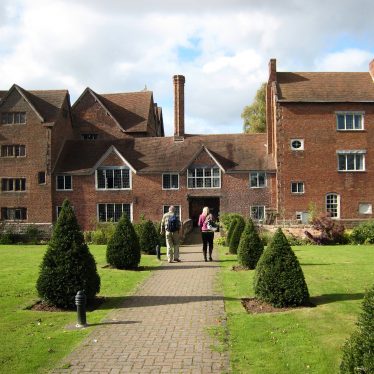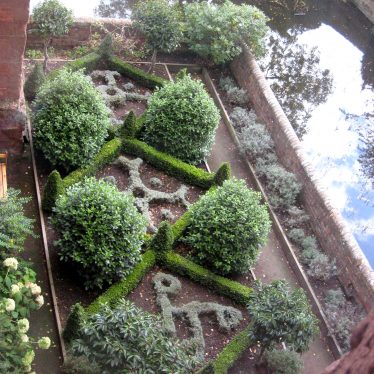Harvington Hall in Worcestershire is a fine Elizabethan moated manor house that for many years belonged to the Throckmorton family who are based at Coughton Court in Warwickshire. Sir Robert Throckmorton married Mary Yate in 1686 and she inherited Harvington Hall ten years later. I was interested to hear that the main staircase was moved in 1910 from Harvington to Coughton Court, where it can still be seen today (though I’m not sure whether it is the one shown in the attached photo – can anyone confirm this?). Coughton Court is now in the stewardship of the National Trust and is open to the public. Harvington Hall deteriorated in the 20th century and the Throckmortons sold it in 1923. However it’s now in the care of the Roman Catholic Archdiocese of Birmingham, who have restored and opened it to the public.
Knot garden
The patterns in the knot garden at Harvington Hall display the initials of the families associated with it early on: ‘P’ (for the founder Humphrey Pakington), ‘Y’ (for his daughter Lady Mary Yate) and ‘T’ (for the Throckmortons).
Priest holes
Like the Throckmortons, the Pakingtons were Catholic and Harvington Hall is famous for its priest holes: these are ingeniously hidden in various locations under stairs, behind walls and under floorboards. They are thought to have been created in the 1580s by Nicholas Owen, who also worked at Coughton and was later martryed because of his work for recusant families elsewhere. His handiwork at Harvington survived raids by Protestants hunting for priests during the Reformation, and pillage by Parliamentarian forces in 1644. Indeed some of his priest’s holes were so well hidden they were not rediscovered until the 20th century (and indeed more may remain to be found).










Comments
The staircase from Harvington Hall is now located in the Saloon at Coughton Court. I’ve had a look at some of the past guide books for Coughton Court and it sounds like it is the staircase in the photo with the coat at the bottom, though the coat’s been moved now. If I remember correctly, the staircase has two separate flights down from a central landing, one on the left and one on the right.
I enjoyed visiting Harvington Hall a few years ago and can remember being told that the portraits up on the walls were copies of some of the ones now at Coughton – they called them the “uglies” as the artist had seemingly portrayed the women as having a shadow of a beard (perhaps just a trick of the paint over time)!
I so enjoyed learning the things in this article. Learning about things that otherwise I never would have known. All of this while studying and searching my genealogy, so thanks for writing and recording this for others to learn.
Add a comment about this page